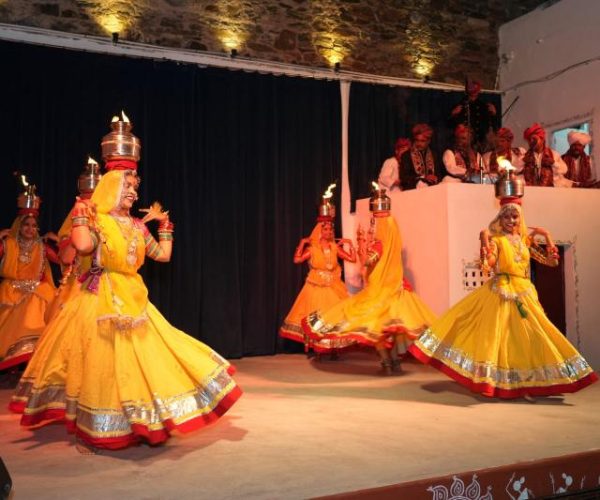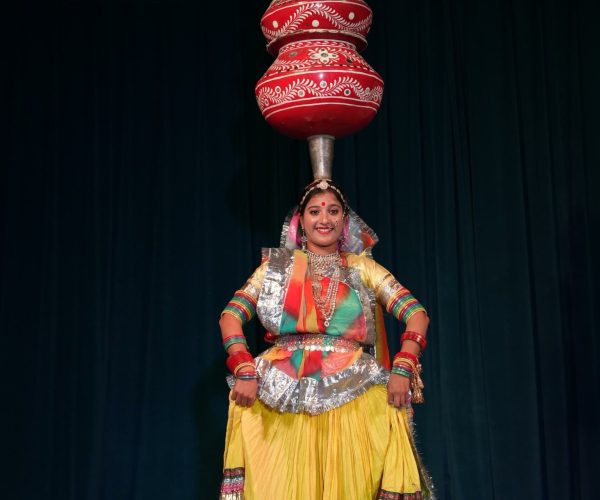Goomar, also known as Ghoomar, is a traditional folk dance from the Indian state of Rajasthan. It is predominantly performed by women during auspicious occasions, such as weddings and festivals like Teej and Holi. The dance is characterized by its graceful and circular movements, with performers twirling in vibrant, flowing skirts called ‘ghagras.’ The dance is accompanied by traditional Rajasthani music and singing, creating a mesmerizing and rhythmic spectacle that reflects the rich cultural heritage of Rajasthan.


Bhavai is a folk dance form that originates from Rajasthan and Gujarat. It is a highly skilled performance art where dancers, usually women, balance multiple brass or earthen pots on their heads while executing intricate and graceful movements. Sometimes, performers also balance other objects like glass bottles, metal pitchers, or even lighted lamps. Bhavai is often performed at festivals, fairs, and weddings, showcasing the dancers’ balance, poise, and agility. It is accompanied by traditional music, which enhances the dramatic and captivating nature of the dance.
Terah Taal, meaning “thirteen beats,” is a traditional dance form of Rajasthan performed by the Kamar tribe. The dance involves the use of small cymbals, known as ‘Manjeeras,’ which the dancers tie to their hands and feet. As they move, they strike the cymbals in a coordinated rhythm that corresponds to the beats of the music. The performance usually features thirteen cymbals, hence the name Terah Taal. This dance is known for its rhythmic complexity and the skill required to synchronize the movements with the music, making it a fascinating spectacle.


Barat dance, also known as Baraat, is an energetic and joyous dance performed during Indian weddings. It typically occurs during the groom’s procession to the bride’s house. Friends and family members of the groom, often accompanied by a live band or DJ playing upbeat music, engage in spontaneous and exuberant dancing. The dance is characterized by lively movements and a celebratory atmosphere, reflecting the joy and excitement of the wedding festivities. It is a significant part of the cultural tradition, symbolizing the joyous union of two families.
Gangaur is a festival celebrated in Rajasthan and some parts of Gujarat, dedicated to Goddess Gauri, a manifestation of Parvati. The Gangaur dance is performed by women during this festival to honor the goddess and seek her blessings for marital bliss and prosperity. The dance involves intricate footwork, graceful hand movements, and synchronized group formations. Women dress in their finest traditional attire and perform the dance to the accompaniment of folk songs and music, creating a vibrant and devotional atmosphere.


Chakra dance is a traditional folk dance that incorporates the use of circular movements and formations, symbolizing the wheel (chakra). This dance form is prevalent in various regions of India, each with its unique style and interpretation. The dance is often performed in groups, with dancers forming intricate patterns and circles, creating a dynamic and visually appealing performance. Chakra dance is typically accompanied by traditional music and is performed during festivals and celebrations, reflecting the cyclical nature of life and the universe.
Duff dance, also known as Duff Sawan dance, is a traditional folk dance performed in Rajasthan. The dance gets its name from the ‘duff,’ a large frame drum used as the primary musical instrument. Performers, often men, play the duff while dancing energetically in coordinated steps. The dance is usually performed during the monsoon season (Sawan), celebrating the arrival of rains and the rejuvenation of nature. Duff dance is characterized by its vibrant, rhythmic drumming and lively movements, creating an atmosphere of joy and celebration.


Chari dance is a traditional folk dance from Rajasthan, performed by women to celebrate joyous occasions such as weddings and festivals. The distinguishing feature of this dance is the balancing of brass pots or ‘chari’ on the dancers’ heads, often with a burning lamp inside. The dancers execute graceful and rhythmic movements while maintaining the balance of the pots, showcasing their skill and poise. The dance is accompanied by traditional Rajasthani music and is often performed in colorful, elaborate costumes, making it a visually captivating performance.
Mayur Dance, also known as the Peacock Dance, is inspired by the elegant and beautiful movements of a peacock. This dance form is prevalent in various parts of India, especially in the state of Uttar Pradesh. Performers, often dressed in costumes resembling peacock feathers, imitate the bird’s gestures and movements. The dance is characterized by its fluidity, grace, and expressive hand gestures, depicting the peacock’s courtship behavior. Mayur Dance is a significant part of Indian classical and folk dance traditions, celebrated for its aesthetic beauty and symbolic representation of nature.


Kalbeliya dance, also known as Kalbelia or Sapera dance, is a traditional dance of the Kalbeliya tribe of Rajasthan, who were once snake charmers. The dance is performed primarily by women in flowing black skirts adorned with traditional embroidery and jewelry. The movements of the dance are sinuous and fluid, resembling the graceful motions of a serpent. It is accompanied by folk music played on instruments like the ‘pungi,’ ‘dholak,’ and ‘khuralio.’ Kalbeliya dance is known for its lively, spirited performance and is a vital part of Rajasthani culture, often showcased at cultural festivals and events.
